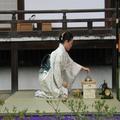Japanese tea ceremony From the Simple English Wikipedia, the free encyclopedia that anyone can change Jump to: navigation, search A woman wearing kimono performs a tea ceremony .
The Japanese tea ceremony (called cha-no-yu , chado , or sado ) is a special way of making green tea (matcha 抹茶).
People who study the tea ceremony have to learn about different kinds of tea. They also have to learn about kimono (Japanese clothes), flowers, and many other things. It takes many years of practice to learn the tea ceremony.
Contents [hide] 1 History 2 Materials needed 3 Tea ceremony 4 Other websites 5 English books about the ceremony // [change] History Tea came to Japan from China in about 900 AD. Tea became very popular in Japan, and Japanese people started to grow tea in Japan.
In the 12th century, matcha (green tea powder), became popular. This tea comes from the same plant as black tea.
By the 16th century, all people in Japan, rich people and poor people, liked drinking tea. A man called Sen no Rikyu started teaching about tea ceremony. Many years have passed, but people still make tea the same way that Sen no Rikyu taught.
[change] Materials needed People need many different things for a tea ceremony: Tea bowl (called chawan 茶碗). In a tea ceremony, people drink tea out of bowls instead of cups. Some bowls that people use are over 400 years old. Tea scoop (called chashaku 茶杓). A scoop is a kind of spoon. Tea scoops are made from bamboo. They are used to put tea into the tea bowl. Large scoops are used to put tea into the tea caddy (see below). Whisk (called chasen 茶筅). A whisk is like a brush made from wire. People use it to mix tea. Tea whisks are made from bamboo. Tea caddy (called natsume or cha-ire 棗、茶入れ). A tea caddy is a special container that people put green tea powder in. There are two kinds of tea caddies: natsume and cha-ire. Natsume are short and have a flat lid and a round bottom. They are made of wood. Cha-ire are tall and thin, and are made of ceramic. Natsume and cha-ire are used in different ceremonies. Napkin (called fukusa 袱紗). A fukusa is a special square cloth made out of silk. It is used to symbolically purify the tea scoop and tea caddy. Ladle (called hishaku 柄杓). The kind of ladle used is made of bamboo. There is a cup-like part attached to a long handle. Tea (called matcha 抹茶). The tea used in the Japanese tea ceremony is pulverized green tea, which is made into a drink during the ceremony by putting some in the tea bowl, adding hot water, and mixing this with the whisk.
[change] Tea ceremony People do the tea ceremony in a special tea room or a special building called a cha-shitsu . Most people wear kimonos.
When people go into the tea room they take off their shoes and sit on special floor mats called tatami.
Cha-shitsu often are very small. The guests (the people who go to the tea ceremony) sometimes eat food and drink special Japanese wine called sake. Before they drink the matcha (green tea) they eat something sweet.
The host (the person who does the tea ceremony) symbolically purifies the tea bowl and the other tea things. Then he or she puts some green tea powder into the tea bowl. The host mixes the tea with hot water. He mixes it with a whisk. The guests drink tea from the bowl.
When everyone has finished drinking tea, the host cleans everything and puts them away. Then the guests leave.
A tea ceremony can take from about twenty minutes to about four hours.

